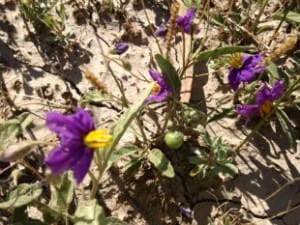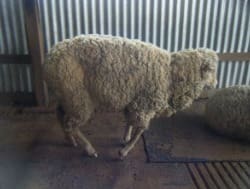
Is Solanum esuralie, also called Quena, potato bush and wild tomato the only cause of Humpy Back?
PASTORAL sheep producers will get the latest insights into the debilitating syndrome Humpy Back at a webinar on February 20.
Queensland and New South Wales producers mustering flocks have reported sheep suffering from the condition this summer.
Queensland’s Department of Agriculture and Fisheries said senior veterinary officer Dr Bindendra Pratap, has been investigating Humpy Back in sheep and has some interesting insights into what might cause the condition, which is different to what was previously thought.
Humpy Back is characterised clinically by a short-stepping, stilted gait of the hind legs, lowering of the head, arching of the back and an inability to continue walking. Stress gastroenteritis and fast noisy heart beat has also been observed.
The webinar organised by Leading Sheep hoped to inform producers why sheep might be dropping off the tail of mobs being mustered in hot weather. It will cover the “real cause” of Humpy Back, why it occurs, which animals are most susceptible and prevention strategies, the DAF said.
Humpy Back has been associated with the consumption of Solanum esuriale, commonly known as quena, potato bush or wild tomato, and Malvastrum americanum, commonly known as spiked mallow, which is generally found six to 10 weeks after good rainfall. Toxins in these plants are thought to cause degenerative changes to the brain and spinal cord.
There has also been evidence to suggest that the condition affects the muscular system rather than the neurological system; however, it may affect both.
Click here to get the latest Sheep Central story links sent to your email inbox.
NSW producers urged to report Humpy Back cases

A Humpy Back sheep.
New South Wales Local Land Services Western Region this week advised sheep producers to be on the lookout and report signs of Humpy Back following a number of suspected cases in recent weeks.
District Veterinarians Dr Charlotte Cavanagh, based in Bourke, and Dr Sophie Hemley, based in Broken Hill, have examined sheep suspected to Humpy Back and they are calling on landholders to keep them informed of other possible cases. Humpy Back is generally seen in extremely hot weather, typically in Merino rams but there have been cases involving wethers and ewes.
Dr Cavanagh said more will be known in coming weeks when the results of several autopsies are available; however, in the meantime she called on landholders to be vigilant when handling stock.
“We’ve had cases of landholders describing around 10 percent of their ram flock forming a tail in the mob and “going down” after walking with a hunched back,” Dr Cavanagh said.
“Affected animals can recover if left to rest and with access to water and shelter, but death will likely occur if the sheep are driven or have no access to water in extreme heat.
“Unfortunately there is no other treatment or cure for humpy back.”
Dr Hemley said producers should consider rescheduling mustering sheep or other management activities to the cooler times of the day like first thing in the morning or late afternoons.
Landholders are encouraged to report incidences of Humpy Back or other staggers-type syndromes in their sheep as more work and research is needed to determine the actual cause and effect of this syndrome.
Dr Hemley said the Humpy Back connection with the plant Solanum esuriale was the “mostly likely association at the moment”.
“However, I don’t think it has been conclusively determined if it is neurological or a muscle problem, or a combination.”
Dr Hemley said there had been several cases reported in the Bourke and Broken Hill areas during recent hot weather.
Queensland’s Department of Agriculture and Fisheries said senior veterinary officer Dr Bindendra Pratap could not be contacted for further information on the “real cause” of Humpy Back.
The webinar will be held on Monday, February 20, from 12:30pm-1:30pm (AEST).
Click here to register for the February 20 webinar.
Sources: Queensland Department of Agriculture and Fisheries, NSW Local land Services Western Region.

HAVE YOUR SAY